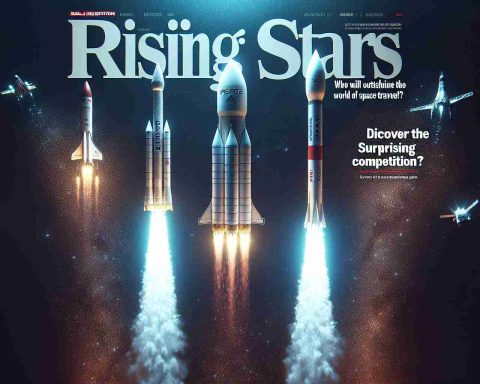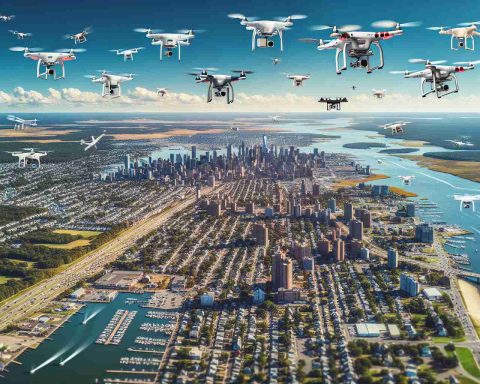A New Era of UFO Investigation Leveraging AI Technology
The weeks following Thanksgiving 2024 marked a significant increase in UFO sightings over New York and New Jersey, captivating public interest and spurring government inquiry. While this isn’t unprecedented, the methods being employed to understand these mysteries are rapidly evolving thanks to technological advancements.
AI’s Role in Modern UFO Analysis
The U.S. government’s approach to UFO phenomena now prominently features artificial intelligence. AI technology is being utilized to sift through vast amounts of data collected by the All-domain Anomaly Resolution Office (AARO), which was established to track and analyze unidentified incidents occurring across air, sea, and space. As AI algorithms become more sophisticated, they’re expected to unveil patterns and anomalies that were previously undetectable.
Cutting-Edge Tools in Surveillance
Recent advancements in satellite surveillance technologies are enabling scientists and investigators to monitor and document aerial phenomena more accurately. These innovations allow for real-time tracking and categorization, improving response times and the accuracy of analyses. As these technologies continue to develop, they are expected to play a crucial role in distinguishing between benign and potentially threatening objects.
Integrating Public and Scientific Efforts
Public curiosity about potential government cover-ups has led to increased transparency and the release of over 2,700 pages of previously classified documents by the CIA. The collaboration between agencies like NASA and the U.S. Department of Defense not only broadens the scope of research but also ensures a multi-faceted approach to understanding these phenomena.
Future Implications and Scientific Revelations
The ongoing exploration of unidentified aerial phenomena (UAP) through AI and other innovations promises breakthroughs that may redefine our understanding of science and the universe. As public interest continues to drive these investigations, both scientific communities and impassioned individuals keenly await the revelations that lie ahead.
AI and UFO Investigation: Environmental, Economic, and Future Implications
The surge in UFO sightings over New York and New Jersey has led to a groundbreaking approach in analyzing unidentified aerial phenomena (UAP) using cutting-edge technologies. The integration of artificial intelligence (AI) in these investigations is reshaping the methodology of governments and agencies, with significant implications for the environment, humanity, the economy, and potentially, the future of our world.
# Environmental Impact
The use of AI and satellite surveillance in UFO investigations is directly impacting how we monitor and understand our environment. The technology used to track and assess aerial phenomena can be repurposed to monitor climate change, uncover patterns in climate data, and detect environmental anomalies. With enhanced surveillance capabilities, researchers can develop more accurate climate models and early warning systems for natural disasters, fostering a proactive approach to environmental conservation.
# Economic Considerations
The deployment of advanced technologies in UFO research presents numerous economic opportunities. AI-driven data analysis can lead to advancement in sectors like aerospace, defense, and technology development, potentially generating jobs and fostering innovation. Furthermore, these technologies could attract significant investment in tech startups and AI research companies, boosting economic growth. On a broader scale, breakthroughs in understanding UAPs might open new avenues in space exploration and resource utilization, providing long-term economic benefits.
# Social and Global Implications
The heightened transparency and public accessibility to previously classified government documents exemplify a shift toward open communication. This approach has the potential to foster trust between governments and citizens, crucial for societal cohesion. The collaboration between public and scientific entities to solve the mysteries surrounding UAPs shows a promising avenue for addressing other global challenges that require collective efforts, such as pandemics or international conflicts.
Moreover, as AI continues to evolve, it introduces questions about ethics and the scope of artificial intelligence in analyzing global phenomena. Striking a balance between technological advancement and ethical responsibility will be essential to ensuring AI serves humanity positively rather than exacerbating existing societal issues.
# The Future of Humanity
The integration of AI and advanced technologies in UFO investigations is a microcosm of a larger trend towards leveraging AI for solving existential mysteries. These endeavors open unexplored possibilities about our universe and spark curiosity and philosophical inquiry regarding extraterrestrial life and our place in the cosmos. As we edge closer to potential discoveries about UAPs and their origins, the collective imagination of humanity is challenged and inspired to envision a future that includes broader cosmic perspectives and innovations.
In conclusion, the role of AI in UFO investigations extends beyond answering the intrigue of extraterrestrial life. It has profound implications for environmental monitoring, economic growth, social trust, and the futuristic outlook of humanity. This frontier of discovery underscores the intertwined nature of scientific exploration and societal evolution, ultimately shaping how we engage with the universe and each other.
Unlocking the Secrets of UFOs: AI Takes Center Stage
AI-Driven Insights: Transforming UFO Investigations
Amidst the increasing number of UFO sightings, particularly over New York and New Jersey post-Thanksgiving 2024, the fusion of AI technology and traditional investigation methods is yielding unprecedented insights into unidentified flying objects. The integration of AI into this field marks a new era, offering capabilities that were once thought to be out of reach.
Pros and Cons of AI in UFO Analysis
Pros:
– Enhanced Data Processing: AI excels at sifting through vast datasets, identifying patterns far beyond human capability. This is crucial for analyzing data collected by the All-domain Anomaly Resolution Office (AARO).
– Real-Time Surveillance: AI-powered tools enable real-time analysis, allowing for immediate categorization of sightings, which improves incident response times.
– Improved Accuracy: AI can reduce human error and bias in the interpretation of data, providing a more objective analysis of potential phenomena.
Cons:
– Dependence on Technology: Reliance on AI may overshadow human expertise and intuition, which have been integral to UFO investigations.
– Data Privacy Concerns: The collection and analysis of massive volumes of data raise privacy issues that need addressing.
– Technology Misinterpretations: Without proper oversight, AI may misinterpret benign objects for threats due to data noise or errors.
The Role of Satellite Surveillance
The latest innovations in satellite surveillance technologies are proving pivotal in UFO investigations. Capable of monitoring large swathes of the sky with high precision, these tools offer a clearer, more comprehensive view of potential anomalies. They serve as an essential complement to AI technologies, offering crucial data that enhance analytical capabilities.
Security and Privacy in AI-Driven Investigations
Security and privacy remain paramount concerns as AI systems process sensitive data related to UFO sightings. Ensuring that AI-driven surveillance efforts are secure and respectful of individual privacy is critical. Measures are continually developed to safeguard data, maintaining the delicate balance between national security and citizen privacy.
Predictions and Future Trends
Looking ahead, AI’s role in UFO analysis is poised for expansion. Future trends suggest that increasingly sophisticated AI models will emerge, capable of learning from new data to enhance their accuracy and efficacy. As AI technologies continue to evolve, new insights into UAP may fundamentally shift scientific paradigms and our understanding of the universe.
For those seeking further information on cutting-edge technological advancements, AI developments, and their applications in various fields, consider visiting NASA’s website and the Department of Defense for additional resources and updates.




















